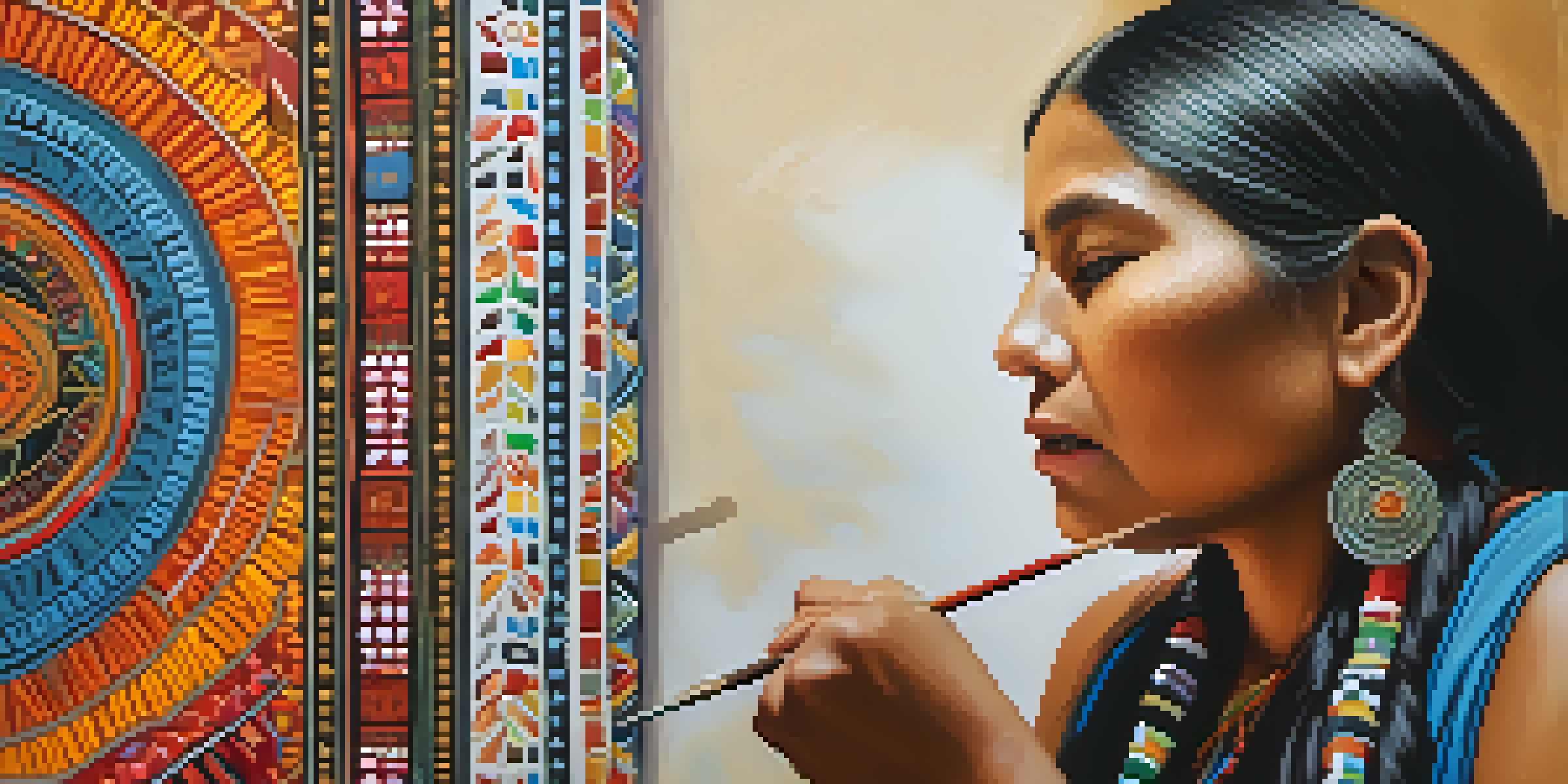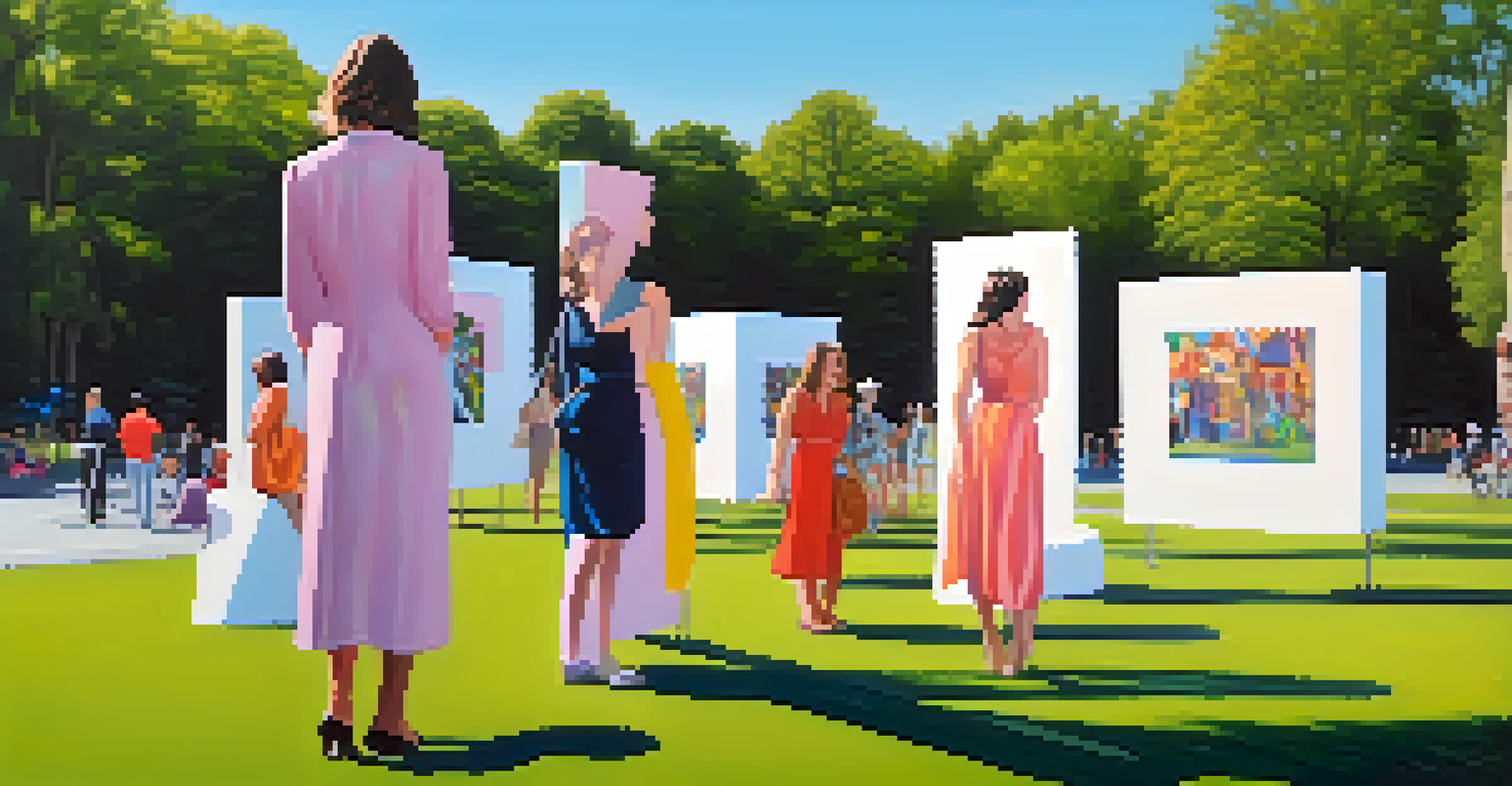The Role of Women in Shaping Cultural Painting Traditions

Historical Perspectives on Women in Art
Throughout history, women have played significant, yet often overlooked, roles in the realm of painting. From ancient civilizations to modern times, female artists have contributed to cultural narratives through their unique perspectives and creativity. For instance, during the Renaissance, women like Sofonisba Anguissola and Artemisia Gentileschi broke barriers, challenging societal norms and paving the way for future generations.
Art is the most beautiful of all lies.
These women not only created art but also influenced the cultural dialogues of their respective eras. Their works often depicted themes of femininity and domesticity, offering insights into the lives of women and society at large. By examining their contributions, we gain a richer understanding of how cultural painting traditions were shaped by female experiences.
The legacy of these pioneering women continues to resonate today, inspiring countless artists to explore their identities and cultural backgrounds. As we reflect on their achievements, we recognize the importance of inclusivity in art, highlighting how diverse voices enrich our understanding of culture and creativity.
Women as Custodians of Cultural Heritage
In many cultures, women have traditionally served as custodians of artistic practices, passing down techniques and styles through generations. For example, in Indigenous communities, women have often been the keepers of traditional painting methods, using art to tell stories and preserve history. These practices not only safeguard cultural heritage but also empower women within their communities.

By embracing their roles as educators, women ensure that cultural narratives continue to thrive, adapting them to contemporary contexts while maintaining their essence. This transmission of knowledge fosters a sense of belonging and identity, reinforcing the importance of women in the artistic landscape. Their contributions help to sustain cultural painting traditions that might otherwise be lost to time.
Women Shaping Art History
Throughout history, women have made significant contributions to art, often challenging societal norms and enriching cultural narratives.
Moreover, as visibility and recognition of female artists increase, we see a resurgence of interest in these traditional practices. Women are reclaiming their place in the art world, advocating for their stories and experiences to be acknowledged and celebrated, ultimately enriching our cultural tapestry.
Influence of Women in Contemporary Art Movements
In contemporary art, women continue to challenge conventions and redefine cultural painting. Movements such as feminist art have emerged to highlight the unique perspectives and experiences of women through visual storytelling. Artists like Frida Kahlo and Yayoi Kusama have not only created iconic works but also sparked conversations about identity, mental health, and societal roles.
The role of the artist is to make the revolution irresistible.
These contemporary artists use their platforms to address issues that resonate with a broad audience, fostering dialogue on topics such as gender equality and cultural representation. Their innovative approaches to painting reflect the complexities of modern life, showcasing how women's voices are essential in shaping the future of art.
As we appreciate these contributions, it's clear that women's influence in painting is far-reaching and transformative. They are not just participants in art movements; they are leaders and innovators, continuously pushing boundaries and inviting new perspectives into the cultural conversation.
The Role of Women in Art Education
Education plays a crucial role in empowering women artists, and many have taken on the mantle of educators themselves. By teaching painting techniques and art history, women are not only sharing their skills but also inspiring the next generation of female artists. Programs and workshops led by women encourage creativity and self-expression, helping to build confidence in young creators.
Moreover, these educational initiatives often focus on cultural painting traditions, ensuring that the rich heritage of women's contributions is not forgotten. By integrating these teachings into art curricula, educators highlight the importance of diverse perspectives in shaping artistic narratives. This approach fosters an inclusive environment where all voices can be heard and valued.
Custodians of Cultural Heritage
Women have traditionally preserved artistic practices, ensuring the transmission of cultural narratives and empowering their communities.
As women continue to shape art education, they are also advocating for systemic changes within the art world. By promoting equitable access to resources and opportunities, female educators are creating pathways for aspiring artists, ensuring that the legacy of women in cultural painting traditions endures.
Intersection of Feminism and Cultural Painting
Feminism has profoundly influenced cultural painting, allowing women to explore and express their identities through art. This intersection has led to the emergence of powerful visual narratives that challenge gender norms and societal expectations. Artists like Judy Chicago and Kara Walker utilize their work to address issues of race, gender, and power dynamics, pushing viewers to confront uncomfortable truths.
By examining these themes through the lens of cultural painting, artists invite audiences to engage in meaningful discussions about feminism and its implications in today's world. The blending of cultural heritage with feminist ideals creates a rich tapestry that reflects the complexities of women's experiences. It serves as a reminder that art is not merely a reflection of society but also a catalyst for change.
As we celebrate the role of women in this intersection, we recognize the importance of their voices in shaping cultural painting traditions. Their contributions foster a deeper understanding of how art can influence social movements and inspire future generations to advocate for equality and representation.
Global Perspectives on Women in Painting
Women artists across the globe contribute to the richness of cultural painting traditions, each bringing unique perspectives influenced by their backgrounds. For instance, African artists like El Anatsui and Wangechi Mutu incorporate traditional motifs and modern techniques to create thought-provoking works that address cultural identity and history. Their art reflects the intricate relationship between personal experiences and broader societal issues.
In Asia, artists like Yayoi Kusama and Ai Weiwei challenge conventions and explore themes of identity, mental health, and the human experience through their unique styles. By doing so, they not only promote cultural dialogue but also inspire a new generation of women artists to embrace their heritage while pushing boundaries.
Feminism's Impact on Art
The intersection of feminism and cultural painting allows women to express their identities and challenge societal expectations through powerful visual narratives.
These global perspectives highlight the interconnectedness of women's experiences in art, showcasing how cultural painting transcends borders. By celebrating these diverse voices, we enrich our understanding of the world and the myriad ways women shape cultural narratives through their art.
Future Directions for Women in Cultural Painting
Looking ahead, the future of women in cultural painting is promising and filled with potential. As more platforms emerge to showcase female artists, we can anticipate a shift in the art world that embraces diversity and inclusivity. Initiatives aimed at supporting women in the arts are gaining momentum, providing resources and opportunities for emerging talent.
Moreover, as technology advances, women artists are leveraging digital tools to explore new mediums and reach wider audiences. This evolution allows for innovative expressions of cultural painting, blending traditional techniques with modern technology. By embracing these changes, women are poised to redefine the landscape of art in ways that resonate with contemporary society.

As we champion the contributions of women in cultural painting, it is essential to continue advocating for their visibility and representation. By fostering a supportive environment, we can ensure that future generations of women artists thrive, enriching our cultural heritage and inspiring change through their creativity.